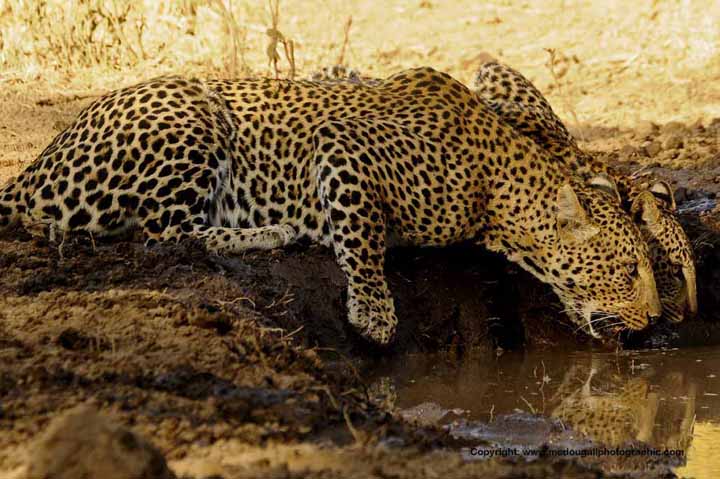Adventure
-Paul
McDougall
Leopard (Panthera pardus)

The Leopard is one of the most widely distributed cats in Africa, but also one of the hardest
to see due to its choice of dense habitat and the fact that it is generally nocturnal. The male Leopard is larger than the female but otherwise both sexes are very similar. The Leopard is a typical cat. Adults only associate long enough to mate and the young
become independent as sub-adults around 22 months. Female territories tend to overlap and they are very tolerant of their female offspring often sharing kills. Leopards are thought to copulate as many times as Lions, they can breed at 2 years and give birth
to 1-3 cubs. Leopards spend the day and part of the night inactive, draped over a tree limb or perhaps lying in a dense thicket. They move around at intervals throughout the night and for a couple of hours after dawn. Leopards although not as vocal as lions
have a very distinct call usually heard in the early evening or at dawn it is a sound very similar to someone sawing wood. A Leopard is the perfect ambush and stalking predator, it seeks to pounce before its prey can react. Leopards can consume antelopes
up to twice its weight although medium sized antelopes like Impala, Reedbuck and Thompson Gazelle form the majority of its diet. After killing its prey the Leopard usually drags it up a tree and caches it there where it returns to feed for several days. A
Leopard kill in a tree is often the closest that many safari goers will get to see this elusive cat. Despite predictions of extermination, it turns out that Leopards are far commoner than conservationists had first thought. The Leopard is successful wherever
the habitat provides reasonable cover and a variety of medium sized antelope for prey. Leopards can be seen in all of the main parks and reserves in Kenya. They are usually seen on a 3 day+ safari to Masai Mara especially around migration time. Lake Nakuru
is also very good for Leopard and has the highest density of Leopards in any Kenyan National Park or Reserve. Saiwa swamp is infamous for its black leopards although these are rarely seen.

It took me 7 years to see my first Leopard, it was always the one animal that I didn’t see on my safaris. But then my luck changed. As you can see from the photographs, I have
now been fortunate enough to get many really good sightings and opportunities to photograph this beautiful cat. My first decent Leopard sighting was in Masai Mara. I was with clients when we stopped the vehicle on a hill, Isaac started to scan the trees with
his binoculars. I stood up and started to do the same, and then through the binoculars, a movement in a big sausage tree, no it couldn’t be I thought, but then it moved again. I said to Isaac that I thought I had found a Leopard, pointed to the tree and he
looked, but he couldn’t see anything, now this guys eyes are amazing and he can spot anything. We agreed that we had time to go and check it out, and as there was a track fairly close we drove back down the hill towards the tree. As we approached – still nothing,
closer and closer, and then as we got within 50 meters of the tree, there it was a beautiful male leopard laying on the branch of the tree, as it heard us approaching, it stood up and looked at us for a few seconds before it ran down the tree and off in to
the bushes. That was my Leopard and nobody could take that away from me. I can honestly say that the adrenaline that you feel from a sighting like that is amazing. After that sighting we had 4 further sightings of different Leopard, those clients on a 2 week
safari had seen more Leopards than I had seen in 7 years of coming to Africa.

|